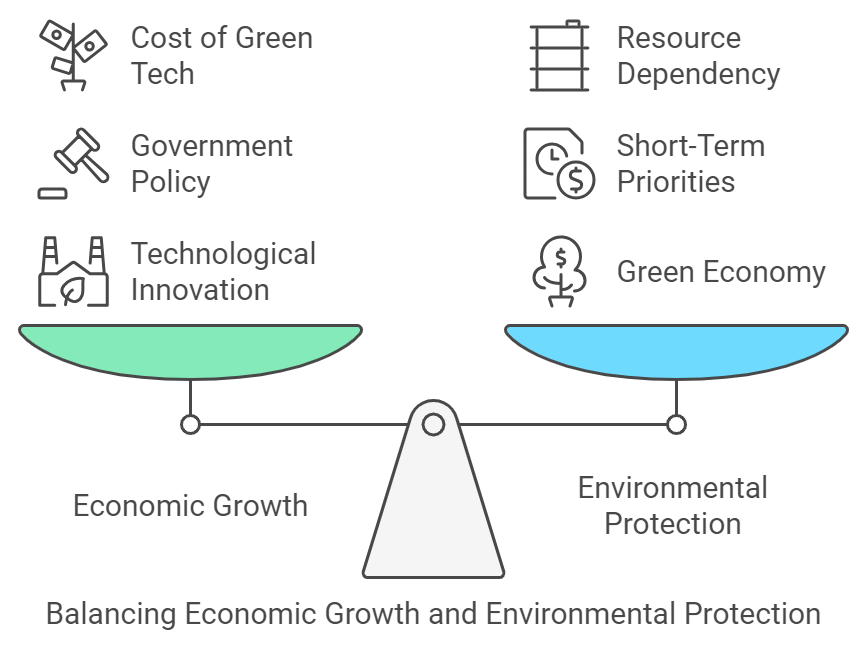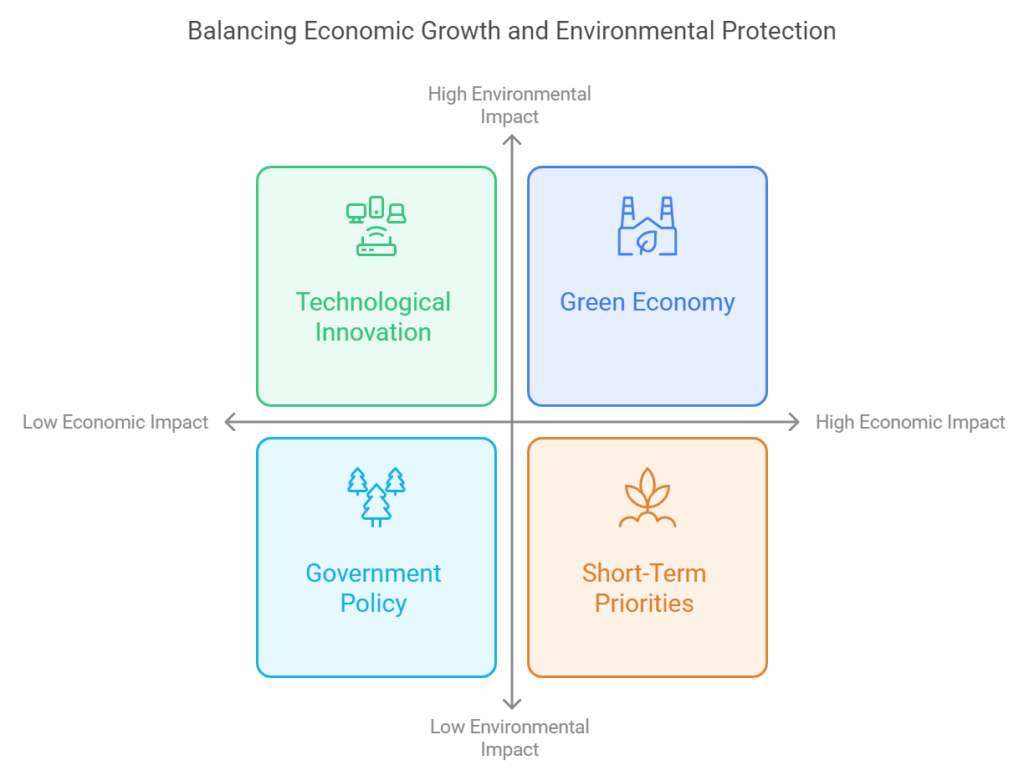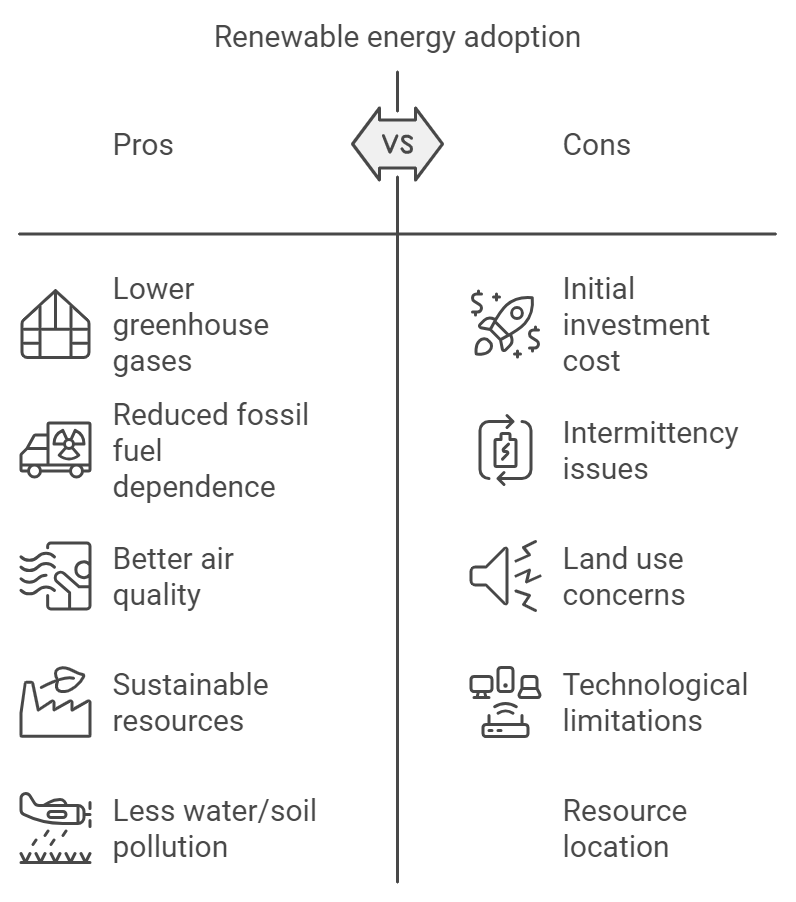目次
- 1 試験概要と流れ
- 2 環境問題に関するよくある質問例
- 3 模範解答の例と観点整理
- 4 What can individuals do to combat climate change?
- 5 Is It Possible to Achieve a Balance Between Economic Growth and Environmental Protection?
- 6 Should Countries Be Required to Reduce Their Carbon Emissions
- 7 How Can Renewable Energy Sources Help in Reducing Pollution?
- 8 What Are the Consequences of Deforestation on Global Biodiversity?
- 9 英作文(意見論述・要約問題)対策テキスト
英検1級スピーキング試験における環境問題対策
英検1級のスピーキング試験では、環境問題がよく取り上げられるトピックです。環境保護や気候変動、生物多様性の保護など、さまざまな観点から問われることがあるため、しっかりと準備しておくことが重要です。
この記事では、環境問題に関する英検1級スピーキング試験の質問例、回答のコツ、効果的な英語表現を紹介します。
試験概要と流れ
- 入室
- 「面接カード」を渡す
- 着席
- 氏名の確認と簡単な日常会話
- 「トピックカード」を受け取る:様々な分野が混ざっている
- スピーチ準備(1分間)
- スピーチ(2分間):概ね180〜240語(話すスピードによって異なる)
- Q&A(4分間)
スピーチの内容に関する2-3の質問 - 「トピックカード」返却
- 退室
トレーニング手順
- カテゴリー(分野)毎に観点とキーワード整理(10分程度)
- 実際にスピーチをして録音して聞き直す(2分+聞き直し)
- 満足できるまで数回繰り返す
- カテゴリー別に話せる様になったら本番形式(トピックが混ざったカード)でトレーニングを行う
環境問題に関するよくある質問例
英検1級のスピーキング試験で出題される環境問題に関する質問の例は以下の通りです:
- What can individuals do to combat climate change?
- Is it possible to achieve a balance between economic growth and environmental protection?
- Should countries be required to reduce their carbon emissions?
- How can renewable energy sources help in reducing pollution?
- What are the consequences of deforestation on global biodiversity?
- 個人が気候変動に対してできることは何ですか?
- 経済成長と環境保護のバランスを取ることは可能ですか?
- 各国は二酸化炭素排出量を削減すべきですか?
- 再生可能エネルギー源はどのようにして汚染の削減に役立ちますか?
- 森林伐採が世界の生物多様性に与える影響は何ですか?
これらの質問に対して、論理的で明確な回答が求められます。
模範解答の例と観点整理
対策初期は、トピック毎に観点整理をするのが効果的です。
色々なトピックについて観点とキーワード整理をしていくうちに、ざっくりと自分の中で分野ごとの語いの引き出しが増えてきます。
それでは質問ごとに「観点とイメージ画像・サンプル論理展開・サンプル回答・対訳」を表示していきますので、まずは流し読みをして全体像をつかみましょう。
What can individuals do to combat climate change?
個人が気候変動に対してできることは何ですか?
気候変動対策には、個人、組織、国家レベルでの取り組みが必要です。ここでは、各レベルで何ができるかを比較してみましょう。
Individual Efforts
- Personal lifestyle changes: Adjusting daily habits, such as reducing energy consumption (エネルギー消費の削減) and adopting sustainable practices (持続可能な慣行の採用).
- Raising awareness: Sharing information on climate change (気候変動に関する情報を共有).
Perspective: While individual efforts are essential, their impact may be incremental compared to systemic changes.
Group/Organizational Efforts
- Corporate responsibility: Implementing sustainable supply chains (持続可能なサプライチェーン).
- Community initiatives: Local clean-up campaigns (地域のクリーンアップキャンペーン).
Governmental Efforts
- Policy and regulation: Enforcing emissions limits (排出制限の施行) and subsidizing renewable energy (再生可能エネルギーへの補助金).
Perspective: Governments have the capacity to enforce policies that drive significant change across society.
模範解答の観点と論理展開
- エネルギー消費の削減:省エネ家電の使用や、無駄な電力の消費を減らすことで個人のカーボンフットプリントを削減できる。
- 持続可能な交通手段:公共交通機関、自転車、徒歩を利用することで、化石燃料の消費を抑えられる。
- 消費行動の見直し:プラスチックの削減、リサイクル、地元で生産された食料品の購入で環境への負荷を軽減。
What Can Individuals Do to Combat Climate Change?
I believe individuals can play a significant role in combating climate change by making simple changes in their daily lives. One way is by reducing energy consumption. People can use energy-efficient appliances, turn off lights when not needed, and lower their heating or air conditioning to save electricity. These small actions can add up and reduce each person’s carbon footprint.
Another effective measure is choosing sustainable transportation options. Instead of driving cars, individuals can use public transportation, ride bikes, or even walk when possible. This reduces the reliance on fossil fuels, which are a major source of greenhouse gas emissions. Carpooling or switching to electric vehicles can also make a difference.
Finally, individuals can rethink their consumption habits. Reducing plastic waste, recycling more, and buying locally-produced food can help lower the environmental impact. Every person’s effort counts, and by adopting greener habits, we can collectively make a significant difference in the fight against climate change. (155 words)
個人が気候変動に対してできること
私は、個人が日常生活において気候変動に対して重要な役割を果たせると考えています。まず、エネルギー消費を減らすことが一つの方法です。省エネ家電を使ったり、不要なときには電気を消したり、暖房や冷房の温度を調整して電力を節約することができます。これらの小さな行動が積み重なることで、個々人のカーボンフットプリントを削減できます。
もう一つの効果的な方法は、持続可能な交通手段を選ぶことです。車を使う代わりに、公共交通機関を利用したり、自転車に乗ったり、歩いたりすることで、化石燃料への依存を減らすことができます。これは、温室効果ガスの排出削減に大きく貢献します。さらに、カープールや電気自動車への切り替えも有効です。
最後に、消費行動を見直すことも大切です。プラスチックの使用を減らし、リサイクルを増やし、地元で生産された食料品を購入することで、環境への影響を減らすことができます。個々の努力が集まることで、気候変動対策に大きな変化をもたらすことができます。
気候変動に関する模範解答を学ぶことで、スピーキング試験での論理的な展開や複雑なトピックに対する自信を身につけましょう。例えば、エネルギー消費の削減や持続可能な交通手段の選択を使って、説得力のある意見を述べることができます。
- アドバイス: 試験では、具体例と自身の見解を組み合わせることで、深みのある回答が可能です。
このトピックを使って、実際のスピーチ形式で練習してみましょう!
Is It Possible to Achieve a Balance Between Economic Growth and Environmental Protection?
経済成長と環境保護のバランスを取ることは可能か?
経済成長と環境保護のバランスを取る方法
気候変動や環境保護は、英検1級のスピーキング試験でよく問われるトピックです。このセクションでは、経済成長と環境保護をバランスよく両立させる方法について解説し、模範解答の論理展開を提供します。

バランスが取れる観点
- Technological Innovation:技術革新
Through technological innovations, such as the development of renewable energy and energy-efficient technologies, it is possible to achieve both economic growth and environmental protection. These technologies can reduce the environmental impact of industries while driving growth.
技術革新を通じて、再生可能エネルギーや省エネ技術の開発により、経済成長と環境保護の両立が可能です。これらの技術は、産業の環境への影響を減らしながら成長を促進できます。 - Green Economy:グリーン経済
By adopting green business models and transitioning to a sustainable economy, countries can grow economically while protecting the environment. Investment in eco-friendly businesses and industries creates jobs and stimulates economic development, without causing environmental degradation.
グリーンビジネスモデルを採用し、持続可能な経済に移行することで、経済成長を達成しながら環境を保護できます。環境に優しい企業や産業への投資は、雇用を創出し、環境を損なうことなく経済発展を促進します。 - Government Policy and Regulation: 政府の政策と規制
Governments can implement regulations that limit environmental harm while providing incentives for businesses to adopt sustainable practices. These policies ensure that economic activities continue without compromising environmental health, creating a balance between growth and sustainability.
政府は環境への被害を抑制しながら、持続可能な取り組みを導入する企業にインセンティブを提供する規制を実施できます。これにより、経済活動を続けながら環境の健康を損なうことなく、成長と持続可能性のバランスを保てます。
バランスが取れない観点
- Short-Term Economic Priorities: 短期的な経済優先事項
In many cases, governments and businesses prioritize short-term economic growth over long-term environmental protection. They may invest in industries that are profitable in the short term but cause significant environmental damage, making it difficult to balance both goals.
多くの場合、政府や企業は長期的な環境保護よりも短期的な経済成長を優先します。短期間で利益を得られる産業に投資することがあり、これが大きな環境被害を引き起こすため、両方の目標のバランスを取ることが困難になります。 - Cost of Green Technology:グリーン技術のコスト
Transitioning to environmentally friendly technologies can be costly, and not all countries or businesses can afford these investments. This financial barrier often prevents widespread adoption of green solutions, hindering the balance between economic growth and environmental protection.
環境に優しい技術への移行はコストがかかり、すべての国や企業がこれらの投資を負担できるわけではありません。この財政的障壁は、グリーンソリューションの普及を妨げ、経済成長と環境保護のバランスを阻害します。 - Resource Dependency:資源依存
Many economies rely heavily on industries such as fossil fuels, mining, and deforestation for their economic stability. Transitioning away from these industries requires significant restructuring, which can result in economic downturns and job losses, making it challenging to achieve a balance.
多くの経済は、化石燃料、鉱業、森林伐採などの産業に大きく依存しており、これらの産業から脱却するためには大規模な再構築が必要です。この過程で経済の低迷や雇用の喪失が生じる可能性があり、バランスを取ることが難しくなります。
模範解答の論理展開と観点
- 持続可能な発展:環境に配慮しながら経済成長を促進するための新技術の開発が可能。
- グリーンビジネスの促進:再生可能エネルギーや環境に配慮したビジネスモデルが経済成長を支える。
- 規制とインセンティブ:政府が環境保護に関する規制を導入し、同時に企業に対するインセンティブを提供することでバランスを取ることができる。
Is It Possible to Achieve a Balance Between Economic Growth and Environmental Protection?
I believe it is possible to achieve a balance between economic growth and environmental protection, but it requires careful planning and innovation. One approach is to promote sustainable development, where new technologies are developed to support economic growth while minimizing environmental harm. For example, advancements in green energy and eco-friendly production processes can help industries grow without causing significant pollution.
Another solution is to encourage green businesses. Companies that focus on renewable energy, recycling, and sustainable agriculture can contribute to both the economy and the environment. These businesses not only create jobs but also help reduce the carbon footprint of their operations. By supporting such businesses, countries can enjoy economic growth while protecting the planet.
Finally, governments play a crucial role in balancing growth and sustainability. They can implement regulations that limit environmental damage while offering incentives for businesses that adopt eco-friendly practices. In conclusion, with the right policies and innovations, it is possible to grow the economy while safeguarding the environment. (162 words)
経済成長と環境保護のバランスを取ることは可能ですか?
私は、経済成長と環境保護のバランスを取ることは可能だと考えていますが、それには慎重な計画とイノベーションが必要です。まず、持続可能な発展を促進するアプローチがあります。これは、新技術を開発し、環境への負担を最小限に抑えつつ、経済成長を支える方法です。例えば、グリーンエネルギーや環境に優しい生産プロセスの進展により、産業は成長しつつも、深刻な汚染を引き起こさないようにできます。
次に、グリーンビジネスの奨励が一つの解決策です。再生可能エネルギーやリサイクル、持続可能な農業に焦点を当てた企業は、経済と環境の両方に貢献できます。これらの企業は雇用を創出するだけでなく、運営の際のカーボンフットプリントを削減します。こうした企業を支援することで、国は経済成長を享受しつつ、地球を守ることができます。
最後に、政府は成長と持続可能性のバランスを取る上で重要な役割を果たします。政府は環境へのダメージを制限する規制を実施し、同時に環境に優しい取り組みを導入する企業にインセンティブを提供できます。結論として、適切な政策とイノベーションがあれば、経済の成長と環境保護の両立は可能です。
技術革新とグリーン経済
- 技術革新: 再生可能エネルギーの開発により、環境負荷を軽減しつつ、経済成長を促進できます。
- グリーン経済: 持続可能なビジネスモデルやエコフレンドリーな産業への投資が、成長と環境保護を両立させます。
関連キーワード: 再生可能エネルギー、持続可能な発展、グリーン経済
模範解答のポイント
- 政府の政策: 規制とインセンティブの両立により、持続可能な成長を支援します。
- 短期 vs. 長期視点: 短期的な経済優先のリスクと、長期的な環境保護の重要性を比較します。
練習問題: 経済と環境のバランスに関する質問を使ってスピーキング練習をしましょう。

Should Countries Be Required to Reduce Their Carbon Emissions
各国は二酸化炭素排出量を削減すべきか?
模範解答の観点と論理展開
- 論点 1: 気候変動の影響を抑える 温室効果ガスを削減することで、地球温暖化を遅らせ、自然災害や海面上昇などの深刻なリスクを軽減できます。
- 論点 2: 国際的な責任 気候変動は国際的な問題であり、特に工業化された国々が協力して排出量を削減する必要があります。パリ協定などの協力は重要です。
- 論点 3: 経済成長と環境保護の両立 再生可能エネルギーへの投資は、環境保護と経済成長を両立できるため、経済を犠牲にすることなく排出削減が可能です。
学習ポイント: このテーマは、英検1級スピーキング試験で頻出のトピックです。上記の論点を使って、模範解答のスピーキング練習をしてみましょう。
Should Countries Be Required to Reduce Their Carbon Emissions?
I believe that countries should be required to reduce their carbon emissions to combat climate change. One reason is that reducing greenhouse gas emissions is essential for slowing down the effects of climate change. If countries continue to emit large amounts of carbon dioxide, global temperatures will keep rising, leading to severe consequences such as more frequent natural disasters, rising sea levels, and loss of biodiversity.
Another reason is that addressing climate change is a shared global responsibility. All countries, especially the major industrialized nations, must work together to protect the environment. While developing countries may need more support, every country has a role to play in reducing emissions. International cooperation and agreements, such as the Paris Agreement, are crucial in achieving this goal.
Finally, reducing carbon emissions can be balanced with economic growth. Investing in renewable energy sources and energy-efficient technologies can help reduce emissions while promoting sustainable economic development.
In conclusion, requiring countries to reduce carbon emissions is not only necessary for protecting the planet but also achievable without sacrificing economic growth. (174 words)
各国は二酸化炭素排出量を削減すべきか?
私は、各国が気候変動に対抗するために二酸化炭素排出量を削減するべきだと考えています。理由の一つは、温室効果ガスの排出削減が気候変動の進行を遅らせるために不可欠だからです。もし各国が大量の二酸化炭素を排出し続けると、地球の気温はさらに上昇し、自然災害の頻発、海面上昇、生物多様性の喪失など、深刻な結果を引き起こす可能性があります。
もう一つの理由は、気候変動への対策は国際的な責任であるということです。特に主要な工業国は、環境を守るために協力しなければなりません。発展途上国にはより多くの支援が必要かもしれませんが、すべての国が排出削減に貢献するべきです。パリ協定のような国際協力と合意が、この目標を達成するために重要です。
最後に、二酸化炭素排出量の削減は、経済成長と両立することが可能です。再生可能エネルギーや省エネ技術への投資は、排出削減を促進しながら持続可能な経済発展を促すことができます。
結論として、各国に排出削減を求めることは、地球を守るために必要なことであり、経済成長を犠牲にすることなく達成できます。
模範解答を基に再生可能エネルギーに関するスピーキング対策を練習しましょう。
How Can Renewable Energy Sources Help in Reducing Pollution?
再生可能エネルギーで汚染を削減する方法
Key Benefits (主な利点)
- Reduction of Greenhouse Gas Emissions (温室効果ガス排出削減): Renewable energy like wind, solar, and hydro power reduces CO2 emissions.
- Decreased Dependence on Fossil Fuels (化石燃料依存の低下): Shifting away from coal and oil reduces air and water pollution.
- Sustainable Resource Use (持続可能な資源利用): Renewable energy is infinite, minimizing resource depletion.
再生可能エネルギー源はどのようにして汚染の削減に役立つか?

Perspectives (観点)
- Reduction of Greenhouse Gas Emissions (温室効果ガス排出削減)
- Renewable energy sources like wind, solar, and hydropower generate electricity without emitting carbon dioxide or other harmful greenhouse gases, which are major contributors to climate change and air pollution.
- Decreased Dependence on Fossil Fuels (化石燃料依存の低下)
- By transitioning to renewable energy, nations can reduce their reliance on coal, oil, and natural gas. These fossil fuels are responsible for significant amounts of air and water pollution, including the release of sulfur dioxide, nitrogen oxides, and particulate matter.
- Improvement in Air Quality and Public Health (空気質と公衆衛生の改善)
- Switching to clean energy sources helps improve air quality by reducing emissions from burning fossil fuels. Better air quality leads to fewer health problems, such as asthma, respiratory diseases, and premature deaths caused by polluted air.
- Sustainable Resource Use and Energy Security (持続可能な資源利用とエネルギー安全保障)
- Renewable energy is derived from natural, inexhaustible sources. This ensures a sustainable supply of energy while reducing environmental degradation associated with extracting and burning non-renewable resources.
- Mitigation of Water and Soil Contamination (水および土壌汚染の軽減)
- Fossil fuel extraction and usage can contaminate water supplies and degrade soil quality through spills, leaks, and runoff. Renewable energy technologies, in contrast, produce little to no water or soil pollution.
論理展開・観点
- 温室効果ガスの排出を削減:再生可能エネルギーは化石燃料に依存せず、CO2の排出を抑える。
- 化石燃料の使用量を減少:風力、太陽光、水力などが化石燃料の代替として機能し、燃焼による大気汚染を防ぐ。
- 環境負荷の低減:再生可能エネルギーは持続可能で、資源を枯渇させることなく長期的に利用可能。
How Can Renewable Energy Sources Help in Reducing Pollution?
Renewable energy sources can play a key role in reducing pollution. One of the main benefits is that they do not produce greenhouse gases like fossil fuels. For example, wind, solar, and hydroelectric power generate electricity without releasing carbon dioxide, which is a major contributor to climate change. By switching to renewable energy, we can significantly reduce our carbon footprint and help slow global warming.
Another way renewable energy helps reduce pollution is by decreasing the use of fossil fuels. Fossil fuels such as coal and oil not only release carbon dioxide but also other harmful pollutants like sulfur dioxide and nitrogen oxides, which contribute to air and water pollution. Using renewable energy sources reduces the demand for these harmful fuels, leading to cleaner air and water.
Finally, renewable energy sources are more sustainable in the long term. Unlike fossil fuels, which are finite and depleting, renewable energy comes from natural sources that are continuously replenished. This means we can reduce pollution without depleting the Earth’s resources.
In conclusion, renewable energy is a cleaner, more sustainable option that can help reduce pollution and protect the environment.
再生可能エネルギー源はどのようにして汚染の削減に役立つか?
再生可能エネルギー源は、汚染の削減において重要な役割を果たすことができます。その主な利点の一つは、化石燃料のように温室効果ガスを排出しないことです。例えば、風力、太陽光、水力は、二酸化炭素を排出せずに電力を生成します。二酸化炭素は気候変動の主な原因の一つであるため、再生可能エネルギーに切り替えることで、私たちのカーボンフットプリントを大幅に削減し、地球温暖化の進行を遅らせることができます。
再生可能エネルギーが汚染削減に役立つもう一つの方法は、化石燃料の使用を減らすことです。石炭や石油などの化石燃料は、二酸化炭素だけでなく、硫黄酸化物や窒素酸化物といった有害な汚染物質も排出し、大気や水の汚染を引き起こします。再生可能エネルギー源を使用することで、これらの有害な燃料の需要を減らし、よりきれいな空気と水を実現できます。
最後に、再生可能エネルギーは長期的に持続可能です。化石燃料とは異なり、再生可能エネルギーは無限に再生される自然資源から得られます。このため、地球の資源を枯渇させることなく、汚染を減らすことができます。
結論として、再生可能エネルギーは、汚染を削減し、環境を保護するためのよりクリーンで持続可能な選択肢です。
What Are the Consequences of Deforestation on Global Biodiversity?
森林伐採が世界の生物多様性に与える影響は何か?
観点 (Perspectives)
- Loss of Habitats (生息地の喪失)
- Deforestation directly leads to the destruction of habitats for countless species, which accelerates the extinction rate, particularly for endemic species that rely on specific forest ecosystems.
- Disruption of Ecosystem Services (生態系サービスの破壊)
- Forests provide critical ecosystem services such as carbon sequestration, water cycle regulation, and soil stabilization. The loss of these services impacts not only biodiversity but also global climate and human well-being.
- Fragmentation and Isolation (断片化と隔離)
- Deforestation often leads to the fragmentation of ecosystems, isolating populations of species and reducing genetic diversity, which weakens the resilience of ecosystems to environmental changes.
- Climate Change Acceleration (気候変動の加速)
- Forests act as major carbon sinks. Their removal contributes significantly to increased atmospheric CO2 levels, which exacerbates global warming and, in turn, affects the survival of temperature-sensitive species.
- Invasive Species and Disease Spread (外来種と病気の拡散)
- The destruction of native habitats makes ecosystems more vulnerable to invasive species and pathogens, which can further degrade biodiversity and destabilize the natural balance of ecosystems.
模範解答の論理展開と観点
- 生息地の喪失:森林伐採によって、多くの動植物が生息地を失い、絶滅のリスクが高まる。
- 生態系の破壊:森林が削られると、食物連鎖や生態系全体に影響を及ぼし、環境のバランスが崩れる。
- 気候変動の悪化:森林は二酸化炭素を吸収する役割を持ち、伐採によって地球温暖化が進行する。
What Are the Consequences of Deforestation on Global Biodiversity
Deforestation has serious consequences for global biodiversity. One of the most significant effects is habitat loss. Forests are home to a wide variety of plants and animals, many of which are found nowhere else on Earth. When forests are cut down, these species lose their homes, and many face extinction as a result. The destruction of rainforests, in particular, has led to the disappearance of countless species.
Another consequence of deforestation is the disruption of ecosystems. Forests play a crucial role in maintaining ecological balance by supporting food chains and providing resources for many organisms. When forests are removed, the entire ecosystem is affected, leading to changes in species populations and the breakdown of natural processes.
Finally, deforestation contributes to climate change, which further threatens biodiversity. Trees absorb carbon dioxide, helping to regulate the Earth’s climate. When forests are destroyed, this carbon is released back into the atmosphere, accelerating global warming.
In conclusion, deforestation not only leads to the loss of species but also worsens climate change, creating a vicious cycle that endangers global biodiversity.
森林伐採が世界の生物多様性に与える影響は何か?
森林伐採は、世界の生物多様性に深刻な影響を与えます。その中でも最も重要な影響の一つは、生息地の喪失です。森林は多くの動植物の住処であり、その多くは他の場所では見つからない種です。森林が伐採されると、これらの種は住処を失い、絶滅の危機に直面します。特に熱帯雨林の破壊は、無数の種の消滅につながっています。
もう一つの影響は、生態系の崩壊です。森林は、食物連鎖を支え、多くの生物に資源を提供することで、生態系のバランスを保つ役割を果たしています。森林が失われると、生態系全体が影響を受け、種の個体数が変化し、自然のプロセスが崩壊することがあります。
最後に、森林伐採は気候変動を助長し、それがさらに生物多様性を脅かします。木々は二酸化炭素を吸収し、地球の気候を調整する役割を果たしていますが、森林が破壊されると、この二酸化炭素が再び大気中に放出され、地球温暖化を加速させます。
結論として、森林伐採は種の喪失を引き起こすだけでなく、気候変動を悪化させ、生物多様性をさらに危険にさらす悪循環を生み出しています。
英検1級英作文(意見論述・要約問題)・二次試験(面接)リストはコチラ
英検1級トピック探しにおススメのサイト:Britanica ProCon.org
英作文(意見論述・要約問題)対策テキスト

「どんなテキストがおすすめですか?」とよく聞かれるのですが、「問題量が多い」ものと「知識量を増やせるもの」の2種類を準備すると良いかと思います。
また、あまりにも文法解説が長いテキストは、英検1級対策としては、「?」という感じがします。
「何を、どんな観点で、どう伝えるか」にフォーカスして書かれたテキストを選んでください。
英作文テキストは、「最低でも3ラウンドする」。語彙や表現を増やす系のテキストは「最低でも5ラウンドする」つもりで、1ページごとに時間をかけすぎず、分からない時はすぐにググりながらテンポよく進めていきます。




